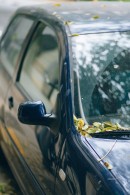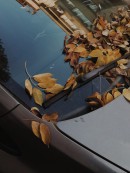Autumn is going strong across the world, which means that many trees are shedding their leaves if they have not done so already. You already know that leaves on the road can be dangerous, but what if they are on your car? Should you remove them instantly, or just leave them alone?
Well, if you were to bet on this and had chosen to remove them, you were right on the money because leaves can cause damage to your vehicle. It is not like bird droppings, but something that “works” (against you) over time.
A few leaves, or the hypothetical situation that involves your vehicle entirely covered in leaves in just hours, will not bring guaranteed damage to your vehicle. Leaving one, two, or a handful of leaves on your vehicle for days or weeks is an entirely different matter, though.
Depending on the species of tree that they came from, the degree of damage varies. We have yet to see any studies that analyze what leaf will hurt your vehicle the most, but that is not that important right now.
All leaves have pollen, sap (from the tree), and a degree of acidity. The last part has the potential to damage the paint or the lacquer on your vehicle, but the former two are dangerous in their own right.
Wet leaves, which may find their way to your vehicle after it has rained, will leave dust marks on your vehicle as it dries after the rain has stopped. While doing so, these wet leaves also leave sap, pollen, and acid into the mix. The acid can “chew in” to your paint finish, while the sap is sticky and can affect the paint finish.
Tree sap can be removed with rubbing alcohol (dabbed on a cloth and then wiped) or a dedicated tree sap remover. Test the latter on a smaller surface before using it on the body, just in case, to be sure there are no reactions between it and your vehicle's paint.
The best possible solution to this problem is to refrain from parking under a tree, or, if you park under the same tree, find out what kind of tree it is and check your vehicle's paint to see if it leaves any sap at the end of the summer or the beginning of autumn. You will recognize tree sap on your vehicle as a sticky residue that resembles wax.
If your vehicle gets covered in leaves regularly, the best you can do is just remove them as soon as possible. Avoid the situation where you leave it parked with leaves on it for days, as further rain will lead to leaves rotting, which will make them even more difficult to remove, not to mention the smell.
Avoid removing leaves with a broom, as it may cause scratches or micro-scratches on the body. Those scratches could come from the leaves being moved or the bristles of the broom, so just use your hands.
While a leaf blower might be your first instinct, we refrain from recommending it, as it could push some leaves under the hood or into other crevices of your vehicle, which would defeat the purpose of the entire action you are undertaking.
Another kind of damage that can be inflicted by leaves on your vehicle refers to air intakes, drain channels for the sunroof, or other drain holes. After you finish picking them up by hand, remove those found in hard-to-reach areas with a vacuum cleaner. Use the same tool on the inner edges of the hood, as well as on the sunroof's tracks.
Be sure to remove all the leaves near the base of the windshield because that is where the vehicle's heater intake system is located. You do not want leaves to get inside it. Just remove as many as you can using your hands and vacuum the rest.
Do the same on the inside of the engine compartment, as leaves will rack up there and begin to decay. The damage they cause in that area is minimal, but they will eventually leave a sticky residue that will be a magnet for dust.
For optimal paint protection, wash your vehicle thoroughly at the end of each season and apply a layer of wax. Ceramic coatings work as well, but this depends on your budget. Ask what is best for your vehicle at a local detailing shop before scheduling an appointment. You can apply the wax yourself if you are on a budget.
A few leaves, or the hypothetical situation that involves your vehicle entirely covered in leaves in just hours, will not bring guaranteed damage to your vehicle. Leaving one, two, or a handful of leaves on your vehicle for days or weeks is an entirely different matter, though.
Depending on the species of tree that they came from, the degree of damage varies. We have yet to see any studies that analyze what leaf will hurt your vehicle the most, but that is not that important right now.
All leaves have pollen, sap (from the tree), and a degree of acidity. The last part has the potential to damage the paint or the lacquer on your vehicle, but the former two are dangerous in their own right.
Wet leaves, which may find their way to your vehicle after it has rained, will leave dust marks on your vehicle as it dries after the rain has stopped. While doing so, these wet leaves also leave sap, pollen, and acid into the mix. The acid can “chew in” to your paint finish, while the sap is sticky and can affect the paint finish.
Tree sap can be removed with rubbing alcohol (dabbed on a cloth and then wiped) or a dedicated tree sap remover. Test the latter on a smaller surface before using it on the body, just in case, to be sure there are no reactions between it and your vehicle's paint.
If your vehicle gets covered in leaves regularly, the best you can do is just remove them as soon as possible. Avoid the situation where you leave it parked with leaves on it for days, as further rain will lead to leaves rotting, which will make them even more difficult to remove, not to mention the smell.
Avoid removing leaves with a broom, as it may cause scratches or micro-scratches on the body. Those scratches could come from the leaves being moved or the bristles of the broom, so just use your hands.
While a leaf blower might be your first instinct, we refrain from recommending it, as it could push some leaves under the hood or into other crevices of your vehicle, which would defeat the purpose of the entire action you are undertaking.
Be sure to remove all the leaves near the base of the windshield because that is where the vehicle's heater intake system is located. You do not want leaves to get inside it. Just remove as many as you can using your hands and vacuum the rest.
Do the same on the inside of the engine compartment, as leaves will rack up there and begin to decay. The damage they cause in that area is minimal, but they will eventually leave a sticky residue that will be a magnet for dust.
For optimal paint protection, wash your vehicle thoroughly at the end of each season and apply a layer of wax. Ceramic coatings work as well, but this depends on your budget. Ask what is best for your vehicle at a local detailing shop before scheduling an appointment. You can apply the wax yourself if you are on a budget.









